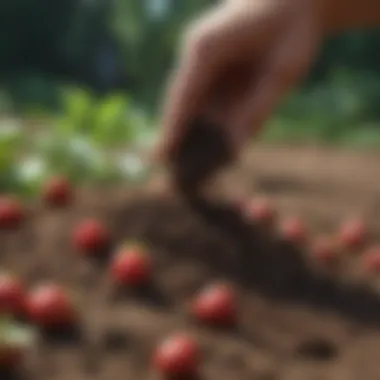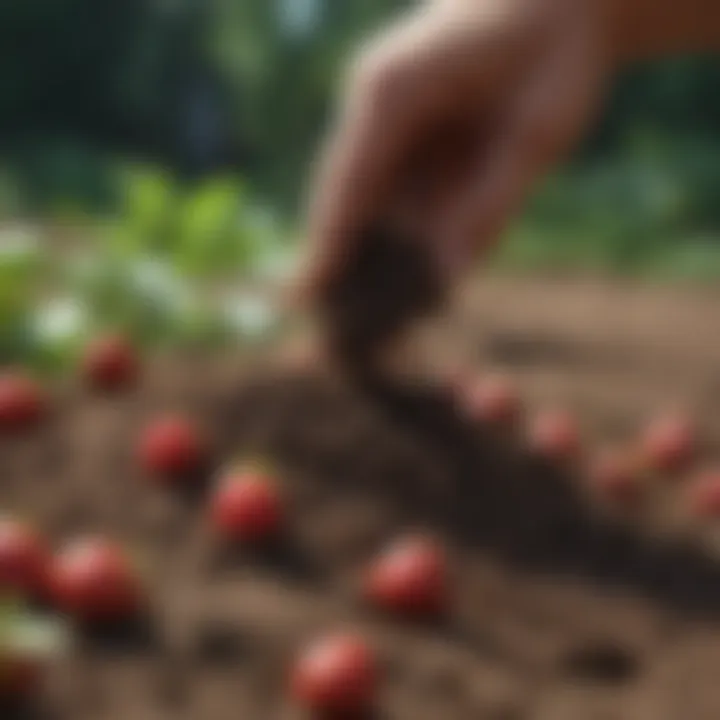Unlocking the Secrets to Optimal Strawberry Fertilizer Requirements


Gardening Know-How
Nutrient Analysis and Customized Fertilization Plan
To ensure that your strawberry plants receive the appropriate nutrients, conducting a nutrient analysis of the soil is crucial. Soil testing laboratories can provide detailed reports on the soil's p H levels, nutrient content, and organic matter. Based on these findings, you can develop a tailored fertilization plan that meets the specific requirements of your strawberries. Organic fertilizers, such as compost and manure, offer a sustainable way to enrich the soil and provide essential nutrients to the plants. Incorporating organic matter into the soil can improve its structure, water retention capacity, and nutrient availability, creating a conducive environment for robust strawberry growth.
Organic Fertilizers and Sustainable Practices
Opting for organic fertilizers is not only beneficial for the health of your plants but also for the environment. Organic fertilizers release nutrients slowly, reducing the risk of nutrient leaching and ensuring a steady supply of essential elements to the plants over an extended period. Additionally, organic practices promote soil fertility and microbial activity, fostering a balanced and resilient ecosystem in your garden. By combining organic fertilizers with sustainable gardening techniques, such as mulching and composting, you can enhance the overall health of your strawberry plants and optimize their growth potential.
Mulching and Water Management Strategies
Mulching plays a vital role in conserving soil moisture, regulating soil temperature, and suppressing weed growth in your strawberry patch. Organic mulches, such as straw or shredded leaves, help retain soil moisture, prevent nutrient loss, and create a protective barrier around the plants' roots. Implementing proper water management strategies, such as drip irrigation or soaker hoses, can ensure that your strawberries receive a consistent water supply without wasting excess water. Adequate hydration is crucial for strawberry plants, especially during flowering and fruiting stages, as water deficiency can lead to poor fruit development and smaller yields. By adopting efficient watering practices and mulching techniques, you can support healthy growth and maximize the productivity of your strawberry plants.
Conclusion
Introduction
In the realm of strawberry cultivation, understanding and optimizing fertilizer requirements play a pivotal role in ensuring the successful growth and abundant harvests of these delicate crops. The efficient utilization of fertilizers tailored to the specific needs of strawberries can significantly enhance their health, yield, and overall quality. This article aims to unravel the intricacies of fertilization for strawberries, guiding cultivators towards a path of informed decision-making and sustainable agricultural practices.
Importance of Fertilization


Fertilization stands as a cornerstone in the cultivation of strawberries due to its direct influence on plant growth, fruit development, and overall productivity. By providing essential nutrients to the strawberry plants, fertilization aids in maintaining optimal soil fertility, thereby fostering a conducive environment for robust growth and high yields. The importance of fertilization also lies in its ability to rectify any existing nutrient deficiencies in the soil, ensuring that the strawberry plants receive all the necessary elements for healthy development. Moreover, a well-executed fertilization regimen can enhance the plant's resistance to diseases and environmental stressors, bolstering their overall vigor and longevity. Therefore, understanding the significance of fertilization is paramount for farmers and gardeners alike, as it forms the foundation for cultivating thriving strawberry plants and reaping bumper harvests.
Understanding Strawberry Nutrient Requirements
Understanding the specific nutrient requirements of strawberries is crucial for their optimal growth and development. In this section, we will delve into the intricate details of the nutrients essential for the health and productivity of strawberry plants. By focusing on key elements such as Iron, Phosphorus, and Potassium, we aim to provide a comprehensive understanding of how these nutrients contribute to the overall well-being of the strawberries.
Key Nutrients for Strawberries
Strawberries have distinct nutritional needs, with Iron, Phosphorus, and Potassium playing vital roles in their growth and fruit production.
Iron
Iron is a crucial nutrient for strawberries as it aids in the formation of chlorophyll, which is essential for photosynthesis. The presence of iron ensures that the plants have vibrant green leaves and can efficiently convert sunlight into energy. Choosing iron-rich fertilizers can significantly benefit the overall health and yield of strawberries. While iron deficiency can lead to yellowing of leaves and stunted growth, an appropriate supply of iron enhances the plants' vigor and productivity.
Phosphorus
Phosphorus is another key nutrient required by strawberries for healthy root development and fruit formation. It promotes overall plant growth, flower initiation, and root establishment. Incorporating phosphorus-rich fertilizers can enhance the resilience of the plants and ensure a robust root system, leading to improved nutrient uptake and increased fruit yield. Striking a balance in phosphorus levels is essential to prevent deficiencies or excesses, both of which can hinder the strawberries' growth.
Potassium
Potassium is vital for various physiological processes in strawberries, including water uptake, nutrient transportation, and disease resistance. It helps regulate the water content of cells, enhancing the plant's tolerance to drought conditions and stress. Selecting potassium-enriched fertilizers can boost the plants' immunity against diseases and ensure the proper functioning of essential enzymes. However, overapplication of potassium may result in nutrient imbalances, necessitating a careful approach to maintain optimal potassium levels for healthy strawberry growth.
Soil Analysis for Precision Fertilization


Furthermore, soil analysis provides crucial insights into the soil's p H levels, which influence nutrient availability to plants. By assessing the pH levels, growers can adjust the soil's acidity or alkalinity to create an optimal environment for strawberry cultivation. Additionally, soil testing helps in identifying the presence of contaminants or pollutants that could hamper plant development. Through soil analysis, growers can fine-tune their fertilization approach, addressing specific soil deficiencies and ensuring that strawberries receive the essential nutrients required for robust growth.
Importance of Soil Testing
Soil testing stands at the core of precision agriculture, offering valuable information that guides farmers in making well-informed decisions regarding fertilization practices. By conducting soil tests, farmers can determine the current nutrient levels in the soil, identify any deficiencies or excesses, and formulate a customized fertilization plan. This process aids in optimizing nutrient management, as growers can supply the necessary nutrients in the right proportions, avoiding wastage and environmental issues.
Moreover, soil testing enables growers to assess the soil's physical properties, such as texture and structure, which impact water retention and aeration. Understanding these aspects allows farmers to enhance soil health and create favorable growing conditions for strawberries. Additionally, soil testing helps in monitoring soil fertility levels over time, allowing growers to adapt their fertilization strategies based on evolving nutrient requirements and crop demands.
Interpreting Soil Test Results
Interpreting soil test results requires a comprehensive understanding of the data provided, as it influences the subsequent steps in the fertilization process. Analysis of soil test results involves examining nutrient levels, p H values, and any potential contaminants present in the soil. Growers need to interpret this information accurately to make informed decisions regarding fertilizer selection, application rates, and timing.
By interpreting soil test results effectively, growers can tailor their fertilization program to address specific nutrient deficiencies or imbalances identified in the soil. Adjusting the fertilizer composition and application schedule based on soil test findings enables growers to provide strawberries with precisely the nutrients they need for optimal growth and development. Furthermore, ongoing monitoring and interpretation of soil test results allow farmers to refine their fertilization practices continuously, ensuring the long-term health and productivity of strawberry plants.
Selecting the Right Fertilizer
Selecting the right fertilizer is a crucial aspect of optimizing the growth and yield of strawberries. The choice of fertilizer can significantly impact the plant's health, fruit quality, and overall productivity. In this section, we will delve deep into the importance of selecting the right fertilizer, highlighting key elements that need to be considered for successful strawberry cultivation.
When deciding between organic and synthetic fertilizers, it is essential to understand the distinctions between the two. Organic fertilizers are derived from natural sources, such as compost, manure, or other plant and animal products. These fertilizers release nutrients slowly as they decompose, providing a consistent source of nourishment to the plants. On the other hand, synthetic fertilizers are manufactured chemically, offering a more concentrated and fast-acting nutrient supply. Understanding the pros and cons of each type is vital in choosing the most suitable fertilizer for strawberries.
In the realm of slow-release versus water-soluble fertilizers, the choice lies in the release rate of nutrients to the plants. Slow-release fertilizers break down gradually over time, ensuring a steady supply of nutrients to the plants over an extended period. This sustained release mechanism minimizes the risk of nutrient leaching and helps maintain soil fertility. Conversely, water-soluble fertilizers dissolve quickly in water, making nutrients immediately available to the plants. While water-soluble fertilizers provide rapid nutrient uptake, they may necessitate more frequent applications compared to slow-release alternatives. Careful consideration of these factors is imperative when selecting the appropriate fertilizer type for strawberry cultivation.
Implementing a Fertilization Schedule


Implementing a proper fertilization schedule is crucial in the cultivation of healthy and productive strawberry plants. This section explores the essential aspects of creating and following a schedule tailored to the specific needs of strawberries, allowing for optimal growth and fruit development. By adhering to a well-structured fertilization timetable, farmers and gardeners can ensure that their strawberry plants receive the necessary nutrients consistently throughout their growing season, promoting overall plant health and yield.
Developing an effective fertilization schedule involves considering various factors such as the stage of plant growth, soil conditions, weather patterns, and the specific nutrient requirements of strawberries at different growth stages. By aligning the fertilization schedule with the plant's growth cycle, growers can maximize nutrient uptake and utilization, leading to enhanced plant vigor and fruit quality. Additionally, a well-planned schedule helps prevent nutrient deficiencies or excesses, minimizing the risk of plant stress and related issues.
Furthermore, implementing a fertilization schedule allows for the systematic application of nutrients, ensuring a steady supply of essential elements for optimal plant performance. By establishing a routine for fertilizer application, growers can maintain nutrient levels within the soil at optimal concentrations, supporting sustained plant growth and development. Consistency in fertilization practices also enables growers to track the nutrient status of their plants over time, making adjustments as needed to address any deficiencies or imbalances that may arise.
Best Practices for Fertilizing Strawberries
In the realm of strawberry cultivation, mastering the best practices for fertilization is of paramount importance. The section on best practices provides invaluable insights that can make all the difference between lackluster harvests and flourishing berry production. Understanding and implementing these practices not only ensures the optimal growth of strawberry plants but also contributes to the overall health and vibrancy of the crop. This section will delve deep into the specific elements that constitute best practices for fertilizing strawberries. It will highlight the benefits of following these practices meticulously and underscore the crucial considerations that farmers and gardeners must bear in mind while fertilizing strawberries.
Avoiding Overfertilization (250-300 words)
Overfertilization, while often well-intentioned, can have detrimental effects on strawberry plants and the environment as a whole. Applying an excessive amount of fertilizer can lead to a build-up of salts in the soil, which in turn can hinder the plant's ability to absorb water and essential nutrients. This can result in stunted growth, leaf burn, root damage, and, ultimately, decreased yield. Moreover, excess fertilizer runoff can pollute water sources, posing a threat to aquatic life. Therefore, it is imperative to strike a delicate balance when fertilizing strawberries, avoiding the temptation to overfertilize in the hopes of achieving quicker results. This section will explore the consequences of overfertilization in detail, providing practical tips on how to prevent it and emphasizing the significance of moderation in fertilization practices.
Monitoring Plant Response (250-300 words)
Monitoring the response of strawberry plants to fertilizer is a fundamental aspect of successful crop management. By closely observing how the plants react to the nutrients provided, growers can make informed decisions about adjusting their fertilization strategy. Signs of nutrient deficiencies or excesses can manifest in various ways, such as yellowing leaves, stunted growth, or leaf tip burn. Regularly inspecting the plants for these symptoms enables growers to intervene promptly and make necessary corrections to prevent further damage. This section will delve into the art of monitoring plant response, elucidating the key indicators that farmers should watch out for and explaining how to interpret these signs accurately. By being attuned to the cues that strawberry plants give, growers can fine-tune their fertilization approach and nurture healthy, thriving crops.
Conclusion
In the intricate world of strawberry cultivation, ensuring proper nutrient balance is paramount to achieving healthy plants and bountiful harvests. This article delves deep into the optimization of fertilizer requirements for strawberries, providing a detailed guide from understanding key nutrients to implementing a precise fertilization schedule. By focusing on nutrient balance, growers can preempt nutrient deficiencies and optimize plant health, leading to improved fruit quality and yield.
For any strawberry grower, the Conclusion section serves as a cornerstone in their cultivation journey. By grasping the significance of maintaining nutrient balance, growers can fine-tune their fertilization practices, ensuring that their plants receive the essential nutrients required for vigorous growth and optimal productivity. Balancing nutrients effectively not only enhances plant resilience to diseases and environmental stressors but also contributes to the sustainability of the cultivation process by minimizing nutrient wastage and environmental impact. Additionally, promoting nutrient balance fosters a holistic approach to strawberry farming, aligning with modern agricultural practices that prioritize efficiency and sustainability.
Ensuring Nutrient Balance for Healthy Strawberries
Strawberries, being heavy feeders, necessitate a judicious approach to nutrient management to thrive optimally. Ensuring nutrient balance in strawberry cultivation involves a multifaceted strategy encompassing soil analysis, fertilizer selection, and diligent monitoring of plant response. By conducting regular soil tests, growers can gather crucial insights into the existing nutrient levels within their soil, enabling them to tailor their fertilization approach to meet their plants' precise needs. Interpretation of soil test results is key to formulating a targeted fertilization plan that addresses any nutrient deficiencies or imbalances effectively.
When selecting fertilizers for strawberry plants, growers must consider the key nutrients required for healthy growth, such as iron, phosphorus, and potassium. Organic versus synthetic fertilizers, as well as slow-release versus water-soluble options, present growers with choices that impact nutrient availability and longevity in the soil. By choosing the right fertilizer type and application method based on soil requirements and plant development stages, growers can optimize nutrient uptake and utilization, fostering robust plant growth and fruit production. Monitoring plant response to fertilization practices is essential in ensuring that nutrient balance is maintained throughout the growing season, allowing growers to make timely adjustments to their fertilization regime based on plant performance.







